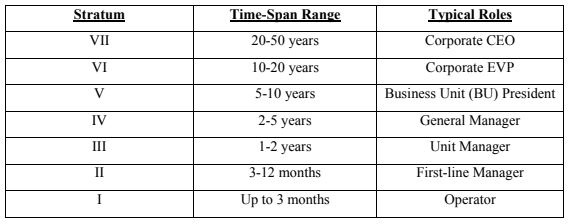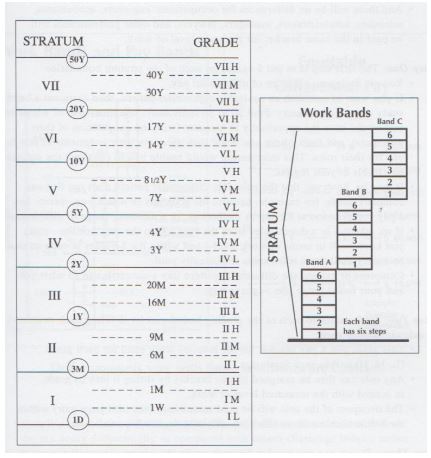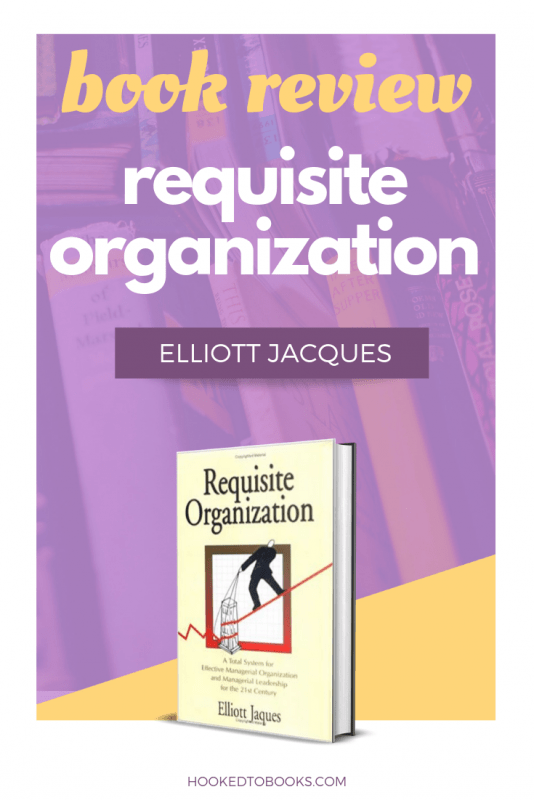Genre: Business Management
Author: Elliott Jacques
Title: Deep Work: Requisite Organization (Buy the Book)
Summary
Requisite Organization, written by Elliott Jacques, presents a theory of how to change the managerial systems of businesses rather than attempting to change the people. This total system is applicable to all types of businesses – industrial, commercial, service, and public – no matter what size.
Jacques’ 50-year history of researching organizational and psychological development has yielded this system that can help solidify a more effective company environment.
This book exhibits a total hierarchical system that can help managers achieve effective organization of businesses. By adopting the traits of a “requisite organization”, businesses are able to be more efficient and competitive, while also unleashing human imagination, trust, and satisfaction in work.
Step by step, Jacques establishes the concepts and then lays out the working procedures of each organization stratum. Throughout the book, he provides a framework which covers the following topics:
- Impacts of human characteristics at work
- The structure of a requisite organization
- The requisite structure of task delegation
- Role complexity in different hierarchical levels of a requisite organization
- The requisite structure of compensation
- Role relationships (or how people work together)
- Managerial leadership practices • Implementation of a requisite organization
Referring to the current conditions of most businesses, Jacques emphasizes the need for change. Furthermore, he states that “the field of organization development and management is at about the same stage of development as were the natural sciences in the mid-sixteenth century.” He highlights several problem areas including excessive organization layers, deceptive performance systems, and ineffective compensation systems.
The topics discussed in this book give objective methods of making organizational decisions in contrast to the traditional subjective methods. For example, Jacques provides an objectively structured compensation plan for business managers to use based on the level of work they contribute to the company.
He also provides concrete implementation steps in addition to objective methodology for a requisite organization. The total timeline to implement a requisite organization is between 6 months and 2 years on average, depending on the size of the company.
About the Author:
Dr. Elliott Jacques is considered to be one of the world’s leading psychologists. Jacques attended Johns Hopkins School of Medicine and then earned a Ph.D. in Social Relations from Harvard University.
Before passing away in March 2003, he conducted 50 years of research on countless organizations in 15 different countries. Jacques is known for coining the term “mid-life crisis”, a transition of identity and self- confidence that can occur to middle-aged people.
With the help of his wife, Kathryn Cason, Jacques discovered an objective method of evaluating the potential capability of individuals. This method has been instrumental in selecting generals for our armed forces, assessing political leaders, and is used by managers in large businesses. Jacques’ discoveries within the social sciences are valuable in better understanding how human nature and social institutions work together.
INTRODUCTION
An ongoing sociopolitical issue exists in the 21st century of how to build an effective organization that will ultimately achieve success. Many academic professors and professionals believe this issue can be solved with simple, singular solutions: “Be customer-oriented”, “Be like the Japanese”, or “Be excellent; and all in a minute” to name a few. In Requisite Organization, however, Elliott Jacques warns against following simplistic solutions like these because they do not offer concepts and principles that can be implemented by executives.
Furthermore, Jacques believes that the current field for organizational development and management is at about the same stage of natural sciences development in the mid- sixteenth century. This speaks to the immature state the field holds; as well as the potential for improvement and growth it has.
In this book, Jacques aims to provide in-depth organizational structures and processes that will lead to business efficiency, business effectiveness, the release of human imagination, trust, and satisfaction in work. The described organizational structures and processes collectively are called a “requisite organization”.
An important distinction of a requisite organization from traditional forms is that it follows a more scientific approach. This foundational approach can make it easier for business executives to implement the requisite organization system.
In order to simplify the system, Jacques lays out concepts to describe different important parts of an organization.
He proposes calling business organizations “Managerial Accountability Hierarchies (MAHs)” since, for lack of an official name, it captures their essential purpose. Within a MAH, leaders are organized in hierarchies of managers and employ people in order to get work done. The total requisite organization system and all its components are justified using the “Stratified Systems Theory (SST)”.
SST establishes a form of a comprehensive system that is requisite for managerial hierarchies. Further concepts will be laid out in the subsequent sections. Overall, Requisite Organization provides executives with efficient structures for hierarchy, delegating tasks, compensation, and role relationships. In addition, it gives managers guidance for determining an employee’s role complexity, role relationships, and managerial leadership.
Jacques’ 50 year analysis of organizations across 15 different countries has led to excessive research to support his findings. This book can be used by business executives as a textbook to understand how to improve the effectiveness of an organization as a whole.
IMPACT OF HUMAN CHARACTERISTICS AT WORK
In order to effectively implement a requisite organization, there are key characteristics of people at work that any MAH must promote: motivation, trust, and values. These characteristics must be satisfied for employees in order to avoid an ineffective organization.
Motivation for people at work comes from two main sources: (1) working at a level in which they can use their full capabilities and (2) a fair compensation system for that work. In addition, people seek having effective managerial leadership that promotes the two main sources. Satisfying these conditions encourages people to enjoy work and become more effective.
Trust is another important characteristic that exists in a requisite organization.
With the average employee spending around 40-50 hours at work each week for up to 40-50 years, it is crucial to have trust in the environment where one spends so much of their life. To put this in a deeper perspective, men and women spend more waking hours in relationships at work than they do in family relationships at home. As a result, a MAH should be a trust-inducing organization to increase the social health of the people within it.
Values are the ultimate driving force for human beings in a MAH, according to Jacques.
A person’s values influence what they give priority to, things they are attracted to, things they will work or fight for, and how much they will put into something. Furthermore, values can be cited as the forces that determine how much a person will commit themselves to a role within a MAH.
This is why it is important for managers to ensure people share the necessary values in required work when hiring for a company vacancy. Equally as important, organizations must establish organizational values that will promote an effective working environment.
In addition to analyzing key characteristics of human beings, a requisite organization must look at the skilled knowledge necessary to perform jobs. This skilled knowledge enables a person to carry out parts of a problem-solving activity without having to think about them. Every MAH is a human judgment system in which people are paid to exercise judgment and make decisions.
According to Jacques, a person with higher skilled knowledge will be able to make better decisions and thus should be higher in the organization structure. In a requisite organization, lower-level employees do not despise higher-level employees; everyone is satisfied working at the level consistent with their current potential.
Many specialists in organizational behavior believe that MAHs must change the psychological group dynamics in order to overcome problems like poor productivity, ineffective working relationships, and interpersonal stresses.
Jacques expresses that this method suggested by many professionals is completely ineffective. Instead, MAHs should make changes in both structure and managerial leadership practices to facilitate changes in the behavior of individuals.
THE STRUCTURE OF A REQUISITE ORGANIZATION
The simple structure of a requisite organization, described by Jacques, is shown in the table below:

As shown, each stratum level represents a different time-span range requirement. Time-span is a direct measure of the level of work of each role (or stratum) within an organization.
Furthermore, the time- span is calculated by looking at the maximum-target-completion-times of tasks required in a role, which is set by managers. For example, the tasks that are given to an operator in stratum I typically take 3 months or less to complete.
Determining the maximum-target-completion-time is one of the most important parts of establishing a requisite organization.
In theory, it is easily calculated. Simply sort out assignments given by a manager to a role and identify the task with the longest target completion time. However, it is more difficult to determine this in practice unless you know a lot about the work required for the assignments.
As a result, Jacques established a best-practice procedure. The manager who is accountable for the role should explore the required tasks to find recurring tasks and others. Ultimately, the manager should arrive at a conclusion of the maximum-target-completion time. For example, some of the longest tasks for accountants at higher levels include accounting development projects and development of accounting departments.
At lower levels, accounting roles may include budgeting or credit control projects that take less time to finish. This situation illustrates the importance of personalized managerial attention when calculating the maximum-target-completion-time.
This method of structuring an organization based the time-span of roles allows managers to objectively look at employees’ effectiveness based on completing tasks on time. In addition, time-span measurement eliminates subjective job-evaluation ratings that make it difficult to determine a fair and simplified pay system.
It is important for the corporate CEO to lay out precise definitions of manager and time-span measurement.
The requisite structure that is shown above in the table provides the solution for clearly defining these terms. However, the total number of layers may change depending on the characteristics of a company.
For example, a company in which the bottom level is a group of financial analysts working in a 3-year time-span (i.e. at stratum IV), the total number of layers is just four—the CEO, two middle- positions, and the financial analysts at the bottom.
The CEO of every MAH is accountable for integrating all of the following functions:
- Developing and improving product/service for clients
- Producing the goods or services
- Procuring materials, components, etc. needed for producing products/services
- Delivering goods/services
- Dealing with specific clients or customers on goods/services provisions
- Marketing needs of the client population as whole, and necessary promotions
- Corporate New Business Development; developing new types of business, which calls for new business units (BUs) or transformation of existing ones
- Financial policies and priorities
- Priorities in flows: scheduling, resourcing, business analysis as required at different levels
- Human resourcing, organizational development, compensation, training
- Working methods technology
- Legal policies, legislative developments
- Public affairs, relations with major organizations other than clients
- Controller: preparation of budgets and accounts
- Auditing: to ensure all managers in all functions are operating within company policy
- Service giving: routine recruitment or training, insurance, maintenance, etc.
As mentioned, every CEO carries the accountability of integrating the functions. However, aspects of these functions can be sourced outside the company or delegated to other stratum levels depending on the work load. For example, if a company operates in a business environment with only a few total clients, then the marketing does not need to be allocated to a lower stratum level.
Instead of hiring a subordinate, the CEO could personally do what little marketing there is to do. On the contrary, if the amount of work in the function is significant, the CEO should establish a subordinate position at a stratum level that matches the complexity and level of work. Overall, the only function that can never be delegated is the managerial function of integrating a subordinate’s work.
In order to determine the number of stratum levels in a company for any given function, start by looking at the outputs they want to produce. This can be done using three simple steps:
- Measure the time-span of roles at the bottom of the function
- Do the same for the role at the top of the function
- Determine the stratum for each role, and count the number of strata in between
The complexity of the level of work in each role will ultimately determine the number of stratum levels in a company. In order to be effective within a requisite organization, functions can then be delegated to lower levels to ultimately produce a finished product/service, or direct output (DO).
THE STRUCTURE OF TASK DELEGATION
In regards to task delegation, a person utilizes Delegated Direct Output (DDO): the process of assigning tasks to others to produce as DO while still remaining accountable for the outputs. Jacques calls the process as DDO “a psychologically interesting situation” since managers are completely dependent on their subordinates to produce acceptable DOs. It is important to note that there is such thing as delegating to too low a level.
Delegating a DO to a level below the capability of a stratum level results in inadequate or failed products/services. This could come in the form of a product/service that takes too long to produce, wastes resources, or is just poor-quality.
On the contrary, assignment to the correct level produces a superior product, in superior time, with minimum resources. Moral of the story: get the correct tasks to the correct level of the organization.
ROLE COMPLEXITY
A valuable tool that executives should acquire is the understanding of problem-complexity. This understanding can help managers identify the current and future potential of people within the MAH. Jacques defines the complexity of a problem as “what you have to do in order to achieve a goal/task”. The level of complexity differs depending on each stratum level.
- Stratum I: Must follow prescribed pathway (do as they have been trained) and use practical judgement to overcome obstacles; he/she must see manager if problem cannot be overcome
- Stratum II: Reflect on what is occurring in order to note potential problems and obstacles; accumulate data to diagnose and prevent future problems; accountable for Stratum below
- Stratum III: Encompass the whole process in a plan and have alternative planned paths if needed; accountable for Stratums below
- Stratum IV: Parallel process multiple interacting projects and prioritize them; make trade-offs between tasks to progress toward the goal; accountable for Stratums below
- Stratum V: Sense inter-connections between the variables in the organization and environment; judge the impact of changes or events internally & externally; accountable for Stratums below
- Stratum VI: Develop networks to accumulate diagnostic information and create environment to judge corporate investment priorities; enhance value of assets (reflected on balance sheet); contribute to corporate long-term success and survival; accountable for Stratums below
- Stratum VII: Develop and pursue alternative world-wide strategic plans; produce BUs through development, acquisitions, mergers, or joint ventures; determine financial resourcing internationally; accountable for Stratums below
Overall, the purpose of understanding problem-complexity in each stratum is for executives to have a more objective way of measuring an employee’s level of work in their role. If an employee performs all complex tasks at their stratum level successfully, it could indicate a promotion is due.
In contrast, a poor performance by an employee may suggest a demotion or layoff is due. This will ultimately determine individuals’ monetary compensation in a requisite organization.
THE STRUCTURE OF COMPENSATION
One of the most controversial topics in 21st century organizations revolves around compensation of employees. Jacques lays out the structure of compensation within a requisite organization that should limit the confusion and unfairness that exists in many organizations.
All people should be paid at comparable levels for comparable work, but this is difficult to measure using subjective job evaluations.
In addition, using market value as compensation is not efficient because it does not reflect the level of work required by each respective position; it is simply a comparison of the compensation to roles with the same titles.
Lastly, structuring compensation using piecework and/or bonus schemes is ineffective because it reflects achieved outputs rather than an individual’s personal effectiveness and level of work.
In a requisite organization, people are compensated for achieved level of work. All employees that are in the same level of work bracket receive the same pay.
This provides a fair system in which a person advances in pay level when their work level increases, which is determined according to their personal effectiveness in work and assessed by their manager.
Under this compensation structure, each stratum is divided into three different pay grades. This allows managers to steadily reward subordinates for progression and increases in merit.
In addition, this structure avoids paying people based on considerations such as gender, race, color, or any attribute other than level of work. Basic steps for implementing this structure are listed below:
- Put dollar values on each of the stratum boundaries
- Fit dollar values to each of the grading boundaries by dividing each stratum boundary dollar value into three parts
- Divide the pay bracket for each grade into six pay steps
- Move the whole differential pay structure by the change in the National Earnings Index
Again, this structure ensures that a MAH objectively determines a person’s compensation based on the level of work. The picture below illustrates what the requisite organization compensation structure looks like when fully implemented:

ROLE RELATIONSHIPS OR HOW PEOPLE WORK TOGETHER
Another fundamental principle of a requisite organization lies within the role relationships. Jacques emphasizes the importance of clarifying and specifying required role relationships at all levels.
This includes teaching everyone who carries the accountability and authority in all working relationships. Clearly stating which people carry these concepts makes it easier for people to get work done between individuals in role relationships.
The two main categories of role relationships are Vertical Task Assignment Role Relationships (TARRs) and Cross-functional Task Initiating Role Relationships (TIRRs). In TARRs, A is authorized to get B to do something and is held accountable for by A’s manager for B’s output. Examples of TARRs include Manager – subordinate, Manager-once-removed (MoR) – Subordinate-once-removed (SoR), and Project team leader – subordinate.
In TIRRs, A is authorized to get B to do something, but B’s manager is held accountable instead of A’s for B’s output. Examples of components of TIRRs include Coordinative, Audit, and Prescribe.
The main takeaway is that each different example mentioned by Jacques exhibits varying levels of accountability and authority. In both categories of role relationships, it is assumed that individuals aspire to work effectively together, regardless of whether they like each other or not. As a result, the clarification of role relationships leads to mutual trust that facilitates effective cooperation.
MANAGERIAL LEADERSHIP PRACTICES
In addition to effective managerial organization, a requisite organization requires the execution of effective managerial leadership. Jacques defines leadership as “the accountability in some to influence one or more others willingly to accept the leader’s purpose and goals and all to move in the direction set by the leader.”
An effective leader avoids using charisma (influence by virtue of attractive personal qualities) and focuses on maximizing his/her own personal competence.
The organizational structure provides a platform for effective managerial leadership because managers are one level higher than the subordinates they lead. This avoids any frustration or resistance from subordinates as they know their managers possess higher capability.
An explanatory factor in why all organizations have not used the requisite organization structure is that leaders have an incorrect view of what the appropriate span of control should be. The traditional view, which was formulated by Italian management expert Graicunas in the 1920s, says that each manager should have between 3-6 subordinates.
This creates excessive numbers of organization levels. According to Jacques, the correct view is that a manager may have any number of subordinates as long as he or she can actually know each person. Depending on the circumstances, a manager can actually have between 1-70 subordinates and still maintain effective leadership.
To determine how effective managerial leadership is in the organization, each manager should ensure that each immediate subordinate manager is doing the following effectively:
- Is the manager regularly meeting with immediate subordinates in managerial team working sessions?
- Is the manager setting context, and regularly updating it?
- Are manager-led two-way planning discussions going on?
- Is task assignment occurring to achieve goals?
- Does the manager engage in personal effectiveness discussions and coaching?
- Do the manager’s evaluations of applied capability of subordinates equilibrate with the judgments of their own subordinates by the manager’s colleagues?
- Is there evidence of good hiring and induction procedures, and of effective hiring/firing judgment and disciplinary action when necessary?
The key to effective managerial leadership by the CEO boils down to accomplishing three tasks for the organization:
- Provide a set of organizational values
- Provide a requisite culture
- Set the long-term outlook and vision
Establishing the organizational values helps employees identify with the organization, which cultivates mutual trust and commitment. The requisite culture supports the values and lays out specific ways of doing things within the company.
Lastly, setting the long-term outlook and vision gives the entire company an idea of the “big picture” of why they are completing different tasks. Collectively, accomplishing these three tasks will help facilitate the necessary leadership for a shift to a requisite organization.
CONCLUSION: IMPLEMENTATION OF REQUISITE STRUCTURE
Jacques’ extensive research throughout his career has given us objective guidelines that can achieve effectiveness in organizations of all sizes. The full scale implementation of these requisite organization guidelines can take between 6 months and 2 years depending on the size of the organization.
In order to facilitate the full implementation, a company should appoint a project officer, who is at least at stratum IV, to oversee the development. Next, the company should teach the ideas and language of a requisite organization to a small group of people (i.e. people at top of organization).
Then, implement the limited pilot testing within one or two departments in the company, or try one component of managerial leadership across the entire company. Lastly, if the pilot testing is successful, then implement the full scale requisite organization starting at the top stratum and working down. Throughout the process, teaching/training and coaching/mentoring will be essential to help the entire organization adapt to the new total system.
In Jacques’ fifty years of research and findings, there is evidence that implementing the requisite organization structure can yield gains of 100% to 200% in organization effectiveness of the MAH. As described, this structure can be implemented for businesses of all types and sizes.
Heeding the advice and implementing the practices outlined by Jacques could jumpstart progress in the field of organizational development and management, which has endless room for growth. Be aware business executives: this total system described by Jacques could potentially help your businesses improve organizational effectiveness here in the 21st century.
Britt always taught us Titans that Wisdom is Cheap, and principal can find treasure troves of the good stuff in books. We hope only will also express their thanks to the Titans if the book review brought wisdom into their lives.

